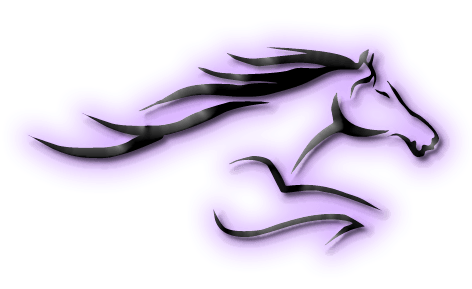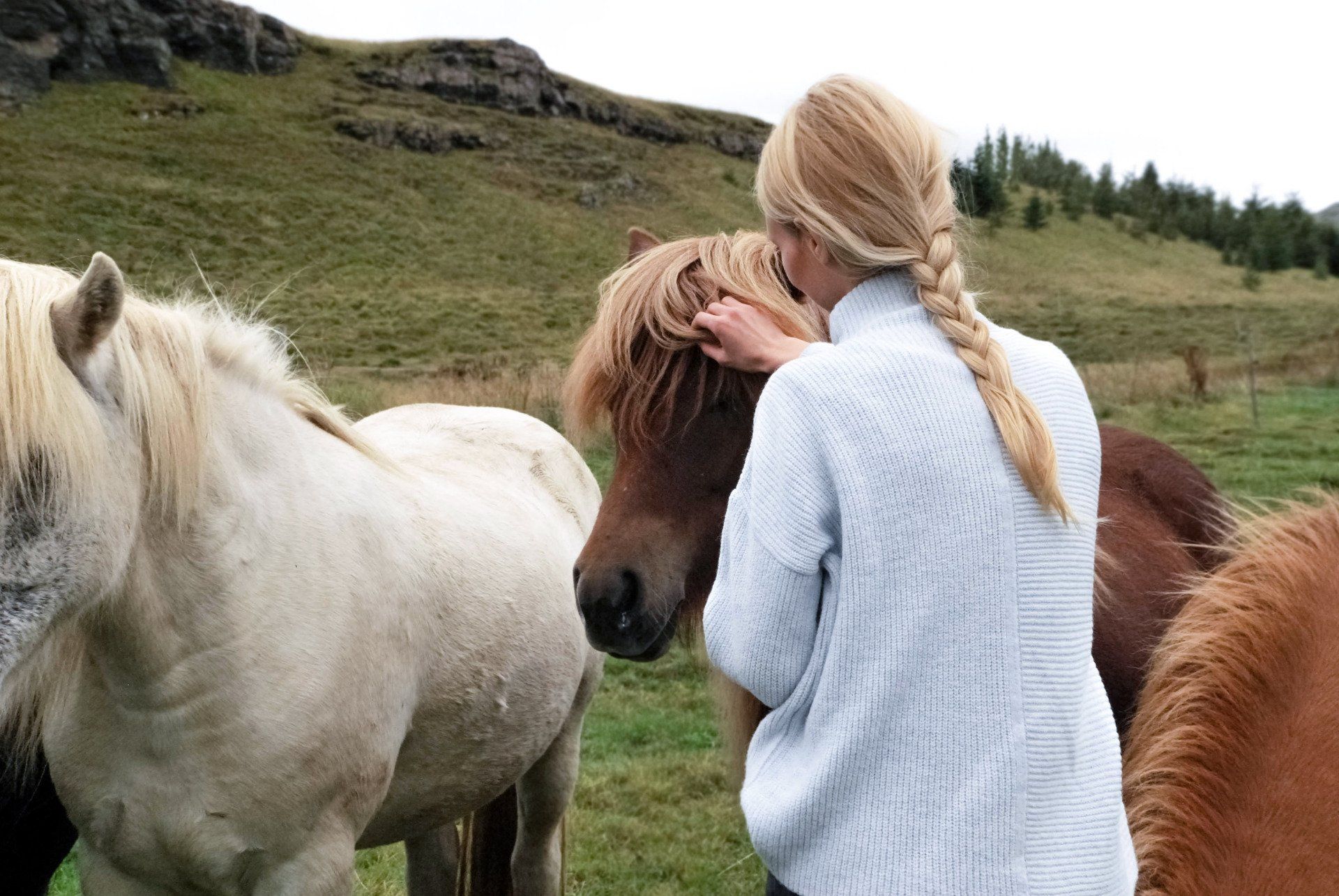"Your horse doesn't care how much you know, until he knows how much you care.
Put your your hand on your horse and your heart in your hand."
- Pat Parelli -
Equine Therapies
The quote above from Pat Parelli also helps describe the intellectual art of equine manual therapies or bodywork. Bodywork is as much about feel, intuition and care for the horse as it is about knowledge of the horse. Using assessment, palpation and watching the reactions of your horse, I am able to determine where issues lie and then rectify with the use of various techniques and tools.
Equine Sports & Rehabilitation Massage Therapy
Massage therapy is a complementary treatment focussing on the fascia, and the superficial and deep muscle layers to alleviate stiffness and soreness and promote healing.
Massage therapy is a great prevention tool as well as aiding in recovery from injury. The benefits of regular massage include:
- improved circulation and respiration
- improved range of movement, flexibility and fitness
- removal of waste and toxins from the body
- increased muscle tone and condition
- loosening of stiff and aching joints
- creation of energy or relaxation depending on the technique used
- rehabilitation after injury
- release of knots, stress points and tension from muscles, tissue and fascia allowing the skeletal frame to settle into its natural state
- support for the immune system
- improved proprioception
- reduced activity of nociceptive pain receptors
- improvements in the overall health and wellbeing of your horse!
I have witnessed the effects of massage on a range of horses from nasal drainage in an asthmatic horse to a favoured limb standing square. It never ceases to amaze me. Your horse will soon settle into the treatment, I generally find that horses appreciate the relief of muscular release and some will work with me leaning into the pressure or adjusting their stance to gain the full benefit of the work.
Your horse's emotional, lifestyle, nutritional, exercise and health routines need to be working correctly to help your horse's body heal, repair and maintain itself. Massage therapy complements these basic requirements and prompts the body to reset itself so it can regain the health and stability of its internal and external systems.
Research shows that massage therapy has a huge benefit for all horses whether retired, leisure or competing.*
*Mike Scott LMT, CSF & Lee Ann Swenson MSc, BSc
Evaluating the Benefits of Equine Massage Therapy: A Review of Evidence & Current Practices
published in the Journal of Equine Veterinary Science
Vol 29, Issue 9, September 2009, pages 687-697.
To read the full paper click
here.
Low Level Laser Therapy
Also known as red light therapy, photobiomodulation or phototherapy, this treatment uses a range of wavelengths to promote faster healing, reduce stiffness and ease other musculoskeletal conditions.
Horses have many layers; the surface, things we can touch like skin and hair, then the superficial muscle layer lying just beneath the skin, followed by the deep muscle layer and then the internal organs, all enveloped in a web of fascia. By moving between various wavelengths, treatment can be targeted exactly where it is needed -
- Red light at 630 and 66o nm. This is visible light and is ideal for superficial damage and inflammation.
- Deep red light at 710 nm. Still visible but appearing much weaker to the eye it penetrates deeper into the superficial muscle layer.
- Near infrared light at 850 and 900 nm. This is invisible to the eye but is effective at treating the deep muscle layer.
Red light therapy activates the release of ATP (adenosine triphosphate) which is the largest carrier of energy to cells increasing chemical reactions to allow the cells to use nutrients faster and remove waste more efficiently. It stimulates the production of collagen which can have a positive impact on scar reduction and is one of the building blocks of cellular growth.
Some horses will experience the benefits in one treatment, while others may take up to 3 weeks. It does depend on the injury or the issue, for example, arthritis will require ongoing treatment while a stress point in a muscle can react immediately.
Myofascial Release & Kinetic Chain Therapy
Myofascial Release & Kinetic Chain Therapy is a gentle, hands-on approach that helps release tension and restrictions in the horse’s fascia - the connective tissue that surrounds all the horses internal structures including muscles and joints. By working with the whole body, this therapy improves movement, posture, and performance, while reducing pain or discomfort.
The horse has eleven kinetic chains in its body, these lines run through landmarks of the body -
- Superficial dorsal - the hind hoof, along the back, to the poll and TMJ. Extends and laterally flexes the neck and back and extends the hip.
- Superficial ventral - the hind hoof, stifle, hip, abdominals, neck and masseter. Flexes the neck, back and hip.
- Deep dorsal - the tail, spine and poll. Supports spinal stability, movement and balance.
- Deep ventral - hind hoof, psoas, abs, organs, nerves, hyoid, tongue. Supports organs, nerves, hip and lumbosacral, cervical ventral flexion.
- Forelimb protraction and retraction. Connects head, withers and hoof cranially and caudally. Enables forward and backwards motion.
- Forelimb abduction and adduction. Connects neck, shoulder and pectorals cranially and caudally. Enables inward and outward motion.
- Functional - trunk to opposite stifle, abs and back to shoulder. Rotates and extends the spine, pairs the legs and stabilises the stifle.
- Lateral - hind hoof, hock, stifle, abs, ribs, neck, head. Facilitates lateral bend and balance, spinal flexion and extension.
- Spiral. Connects around the body in a spiral. Spinal rotation, extension and flexion, lateral neck flexion, stabilises trunk and hock.
Using myofascial release along the horse's kinetic chains, helps identify imbalances and compensations that may lead to stiffness or injury. Together, these techniques support better function, faster recovery, and a happier, more comfortable horse.
Ideal for horses in work, recovering from injury, or just needing a tune-up!
Balance Pads - Introduction & Exercise Prescription
Balance pads are a great way to improve your horse's proprioception, core strength and, stability and coordination. They are also a useful aid for helping recovery from surgery or injury. The pads are made of a thick foam which creates an unstable surface under the foot. By standing on the pads, horses have to make constant adjustments, which activate their deep postural muscles, helping them build strength and become more coordinated and balanced. This makes balance pads a passive activity, unlike a ridden exercise program, where the pads make your horse engage the deep core muscle groups without creating strain or tension.
The program covers -
- clinical history
- assessment & photos of your horse
- introduction to the balance pads
- exercises for the next 4 weeks
- revist at 4 weeks for assessment and follow up
- next lot of exercises for the next 4 weeks
- revisit at a further 4 weeks for assessment and final exercises
This program is fully supported and is completed over 8 weeks. After that, the exercises are to be carried out as recommended. All horses are different, so if your horse takes longer to establish their confidence on the pads between visits, these times can be extended so you get the full benefit of the program. Your own set of balance pads to keep are included!
It is imperative that we have a safe area with a flat, clean, dry surface to work. Hooves must be clean and dry, trimmed to shape and free of any sharp edges. Shoes must be secure and free from protruding nails and studs. You, or your horse's handler who will be completing the program with them, must be present during the visits.
Please note - veterinary referral will be required where your horse is recovering from surgery or injury, or has existing health issues.

